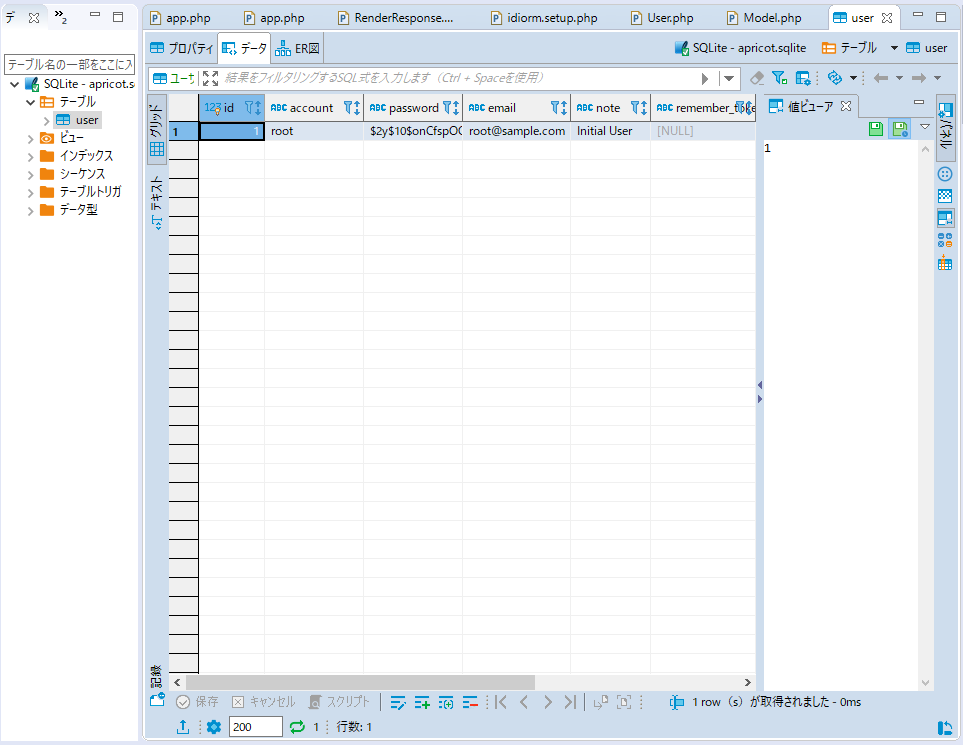目次
Apricot データベースとモデル
— y2sunlight 2020-05-06
関連記事
- Apricot アプリ
- Apricot データベースとモデル
本章ではデータベースの設定とモデルの実装を行います。
データベースの構築
Apricotでは以下のユーザテーブルを持っています。
テーブル名 : user
カラム名 型 主Key 属性 説明 id integer ● autoincrement ID account text unique not null アカウント password text not null パスワード email text not null Eメールアドレス note text 備考 remember_token text 自動ログイン用 created_at text not null 作成日 updated_at text not null 更新日 version_no integer default 0 not null バージョンNo - ユーザ認証は(account,password)で行います
- remember_tokenは自動ログイン用の認証トークンです
- version_noは楽観的ロックで使用します
SQLファイル
Apricotではアプリ起動時にデータベースにテーブルが存在しない時、テーブルを自動生成します。テーブル作成用のsqlは以下のファイルに保存します。このファイルは後述のORMの初期設定ファイルで使用されます。
/apricot/assets/sql
- create.sql
/* * User Table */ CREATE TABLE IF NOT EXISTS USER ( id INTEGER PRIMARY KEY autoincrement, account text UNIQUE NOT NULL, password text, email text NOT NULL, note text, remember_token text, created_at text NOT NULL, updated_at text NOT NULL, version_no INTEGER DEFAULT 0 NOT NULL );
SQLファイルについて
- SQLの文法及び使用できる関数などは使用しているデーターベース(Apricotでは
SQLite)に依存します。 - コメントは行コメント(
–Comment)とブロックコメント(/* Comment */)が使用できます。 - 文はセミコロン(
;)で区切って下さい。 - 連続する空白(
TAB,Space,改行文字)は1つの空白と同じにみなされます。
ORMの設定
設定ファイル
/apricot/config/setting
- idiorm.setting.php
<?php return [ 'sqlite' => [ 'db_file' => var_dir('db/apricot.sqlite'), 'connection_string' => 'sqlite:'.var_dir('db/apricot.sqlite'), 'caching' => true, 'logging' => true, ], 'initial_data' => [ 'user'=> [ 'exec' =>[ 'delete from sqlite_sequence where name=\'user\'', ], 'rows' => [ [ 'account' =>'root', 'password' =>password_hash('', PASSWORD_DEFAULT), 'email' =>'root@sample.com', 'note' =>'Initial User', ], ], ], ], ];
- sqlite : 接続設定(apricotではSQLiteを使用します)
- sqlite.db_file — データベースファイルのパス (既定値は var/db/apricot.sqlite')
- sqlite.connection_string — 接続文字列
- sqlite.caching — キャッシングの有無
- sqlite.logging — ロギングの有無
- initial_data : 初期データ (テーブルが空の時に自動設定されます)
- {テーブル名} — ここではユーザテーブル( user )を指定しています
- exec — 実行したいSQLを記述します(複数指定可)
- rows — 行データを設定します(複数指定可)
接続設定の詳細は以下を参照して下さい:
https://idiorm.readthedocs.io/en/latest/configuration.html#id1
初期設定ファイル
データベースの設定は初期設定ファイルで行います。
/apricot/config/setup
- idiorm.setup.php
<?php //------------------------------------------------------------------- // ORM(idirom)の初期設定 //------------------------------------------------------------------- return function():bool { // データベースファイルの準備 $db_file = config('idiorm.sqlite.db_file'); if (!file_exists($db_path=dirname($db_file))) { mkdir($db_path,null,true); } // DBファイルの存在確認 $new_db_file = !file_exists($db_file); // データベース接続 ORM::configure([ 'connection_string' => config('idiorm.sqlite.connection_string'), 'caching' => config('idiorm.sqlite.caching',false), 'logging' => false, 'logger' => function($log_string, $query_time) { // SQL debug logging \Core\Log::info("SQL",[$log_string]); }, ]); //------------------------------------------- // テーブルの作成 (新しくDBを作った時) //------------------------------------------- if ($new_db_file) { $sql_text = file_get_sql(assets_dir('sql/create.sql')); if (!empty($sql_text)) { foreach($sql_text as $sql) { ORM::get_db()->exec($sql); } } } //------------------------------------------- // 初期ユーザの作成 (ユーザテーブルが空の時) //------------------------------------------- $initial_data = config('idiorm.initial_data'); if (isset($initial_data)) { foreach($initial_data as $key=>$item) { if(ORM::for_table($key)->find_one()===false) { if (array_key_exists('exec', $item)) { // SQLの実行 $exec = (array)$item['exec']; foreach($exec as $sql) { ORM::get_db()->exec($sql); } } if (array_key_exists('rows', $item)) { // 新しいレコードの作成 $rows = (array)$item['rows']; foreach($rows as $row) { $row = ORM::for_table($key)->create($row); $row->set_expr('created_at', "datetime('now')"); $row->set_expr('updated_at', "datetime('now')"); $row->save(); } } } } } // SQLログ開始 ORM::configure('logging' , config('idiorm.sqlite.logging',false)); return true; // Must return true on success };
初期設定ファイルでは以下の事をおこないます:
- データベースの保存フォルダが存在しない場合は作成します
- データベースへの接続
- テーブルの作成 (新しくDBを作った時)
- 初期ユーザの作成 (ユーザテーブルが空の時)
- SQLログの開始 (logging設定がtrueの場合)
アプリケーション設定の変更
上で作った idiorm.setup.php をアプリケーションの設定ファイル(app.php)に追加します。
/apricot/config
- app.php
<?php return [ 'setup' =>[ config_dir('setup/whoops.setup.php'), /* Error handler(whoops) */ config_dir('setup/bladeone.setup.php'), /* View template (BladeOne) */ config_dir('setup/aliases.setup.php'), /* Class aliases for view template and so on */ config_dir('setup/idiorm.setup.php'), /* ORM(idiorm) */ ], 'middleware' =>[], 'auth' =>[], 'csrf' =>[], ];
テスト実行
データベースファイル(apricot.sqlite)を作ってみましょう。ブラウザ上で以下のURLにアクセス、Apricotのホーム画面を表示して下さい。
http://localhost/ws2019/apricot/public/
まだユーザ登録機能を実装していないので、アプリからユーザテーブルの内容を見る事はできませんが、以下の場所にデータベースファイルが作成されていることを確認して下さい。
/apricot/var/db/apricot.sqlite
Sqliteデータベースの内容を確認するには、A5:SQL Mk-2 などのデータベースクライアントを使用して下さい。また、Eclipseからデータベースの内容を参照したい場合は、DBeaverプラグイン が利用できます。
DBeaverプラグインのインストール方法
- メニューから[ヘルプ][新規ソフトウェアのインストール…]を選択
- [–すべての使用可能なサイト–]を選択
- [一般用ツール][マーケットプレース・クライアント]をインストール
- Eclipseの再起動
メニューから[ヘルプ][Eclipseマーケットプレース]を選択- [DBeaver]を検索してインストール
- Eclipseの再起動
DBeaverプラグインの使用方法
- メニューから[データベース][新しい接続]を選択して
apricot.sqliteに接続 - [ウィンドウ][ビューの表示][その他…]を選択
- [データベース][データベースブラウザ]を選択
データベースブラウザから- SQLite - apricot.sqlite をクリック
- SQLiteドライバー(jdbc)をダウンロード(初回のみ)
- [テーブル][user]をクリック

モデルクラス
ORマッパーが使えるようになったので、モデルのベースクラス( Model )を作ります。Modelクラスは必ず継承して使い、以下のメソッドを持ちます。詳しくはソースコードを参照して下さい。
メソッド名 機能 tableName()
:stringテーブル名の取得
テーブル名(snake_case)はクラス名(UpperCamelCase)から自動判定します。for_table()
:ORMORMオブジェクトの取得 findAll()
:array全件検索
ORMの配列を返します。findOne
(int $id):mixed主キー検索
見つかった場合は ORM を、それ以外は false を返します。create
(array $inputs=null):ORMモデルの新規作成 insert
(array $inputs):ORMレコードの挿入 update
($id, array $inputs):ORMレコードの更新
レコードが存在しない時、ApplicationExceptionが発生します。
楽観的ロック例外を検知した時、OptimissticLockExceptionが発生します。delete
($id):ORMレコードの削除
レコードが存在しない時、ApplicationExceptionが発生します。isSuccess()
:bool最新の更新結果を取得します(insert/update/delete) ソースコードを以下に示します。
/apricot/app/Foundation
- Model.php
<?php namespace App\Foundation; use ORM; use App\Exceptions\OptimissticLockException; use App\Exceptions\ApplicationException; /** * モデル */ class Model { /** * 最新の更新結果(insert/update/delete) * @var bool */ private $success = false; /** * テーブル名の取得 * @return string */ public function tableName():string { return snake_case(get_short_class_name($this)); } /** * テーブルの取得 * @return \ORM */ public function for_table():ORM { return ORM::for_table(snake_case(get_short_class_name($this))); } /** * 全件検索 * @return array|\IdiormResultSet */ public function findAll() { return $this->for_table()->find_many(); } /** * 主キー検索 * @param int $id * @return \ORM|false returna single instance of the ORM class, or false if norows were returned. */ public function findOne(int $id) { return $this->for_table()->find_one($id); } /** * 新規作成 * @return \ORM */ public function create(array $inputs=null):ORM { return $this->for_table()->create($inputs); } /** * 新規保存 * @param array $inputs * @return \ORM */ public function insert(array $inputs):ORM { $row = $this->for_table()->create($inputs); $row->set_expr('created_at', "datetime('now','localtime')"); $row->set_expr('updated_at', "datetime('now','localtime')"); $this->success = $row->save(); return $row; } /** * データ更新 * @param mixed $id * @param array $inputs * @return \ORM */ public function update($id, array $inputs):ORM { // ApricotではSQLite3.0.8以上の使用を前提としており、トランザクション分離レベルはデフォルト値がDEFERREDです。 // DEFERRED は最初の読み取り時に共有ロックが掛かります(SQLiteのロックはデータベースロックです)。 // 従って、version_no読み取り後はトランザクション終了まで他の更新は発生しません。 // NOTE: 他のデータベースの場合は、ここで行ロックを取得してレコードの検索を行います(select for update) $row = $this->for_table()->find_one($id); if ($row===false) { throw new ApplicationException(__('messages.error.db.update')); } // 楽観的ロックの検証 if ($row->version_no != $inputs['version_no']) { throw new OptimissticLockException(); } // データ更新 $row->set($inputs); $row->set_expr('updated_at', "datetime('now','localtime')"); $row->set_expr('version_no', "version_no+1"); $this->success = $row->save(); return $row; } /** * データ削除 * @param mixed $id * @return \ORM */ public function delete($id):ORM { $row = $this->for_table()->find_one($id); if ($row===false) { throw new ApplicationException(__('messages.error.db.delete')); } $this->success = $row->delete(); return $row; } /** * 最新の更新結果の取得(insert/update/delete) * @return bool */ public function isSuccess():bool { return $this->success; } }
ORMオブジェクトについては、以下のIdiormのドキュメントを参照して下さい: